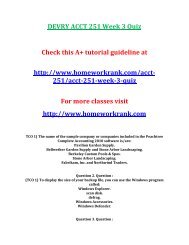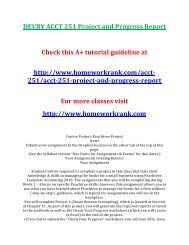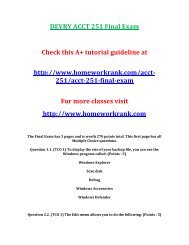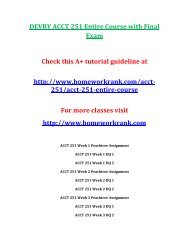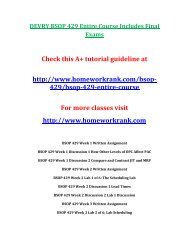DEVRY ACCT 555 Entire Course
You also want an ePaper? Increase the reach of your titles
YUMPU automatically turns print PDFs into web optimized ePapers that Google loves.
We have audited the accompanying balance sheet of Tamarak Corporation as of<br />
October 31, 2009, and the related statements of income, retained earnings, and cash<br />
flows for the past year. These financial statements are the responsibility of the<br />
company’s management. Our responsibility is to express an opinion on these<br />
financial statements based on our audit.<br />
We conducted our audit in accordance with auditing standards generally accepted in<br />
the United States of America. Those standards require that we plan and perform the<br />
audit to obtain reasonable assurance about whether the financial statements are<br />
free of material misstatement. An audit includes examining, on a test basis, evidence<br />
supporting the amounts and disclosures in the financial statements. An audit also<br />
includes assessing the accounting principles used and significant estimates made by<br />
management, as well as evaluating the overall financial statement presentation. We<br />
believe that our audit provides a reasonable basis for our opinion.<br />
The company has included in property and debt in the accompanying balance sheet<br />
certain lease obligations that, in our opinion, should be expensed in order to<br />
conform with generally accepted accounting principles. If these lease obligations<br />
were capitalized, property would be decreased by $4,000,000, long-term debt by<br />
$2,000,000, and retained earnings by $180,000 as of October 31, 2009, and net<br />
income and earnings per share would be decreased by $180,000 and $0.62,<br />
respectively, for the past year.<br />
3. (TCO C) The following situation involves a possible violation of the AICPA’s code<br />
of professional conduct. For this situation, (1) determine the applicable rule number<br />
from the code, (2) decide whether or not the code has been violated, and (3) briefly<br />
explain how the situation violates (or does not violate) the code. Your answer should<br />
be set up something like this:<br />
Rule # _____ Violation? Yes or No.<br />
Provide a one- or two-line explanation.<br />
Auditor Tex Gato of the CPA firm Smackey and Smackey, CPAs, enjoyed auditing his<br />
favorite client, Super Pup Dog Food, because the client would allow him to take home<br />
to his dog a variety of dog food samples that amounted to a year’s worth of dog food.<br />
4. (TCO C) The following situation involves a possible violation of the AICPA’s code<br />
of professional conduct. For this situation, (1) determine the applicable rule number<br />
from the code, (2) decide whether or not the code has been violated, and (3) briefly<br />
explain how the situation violates (or does not violate) the code. Your answer should<br />
be set up something like this:<br />
Rule # _____ Violation? Yes or No.<br />
Provide a one- or two-line explanation.





